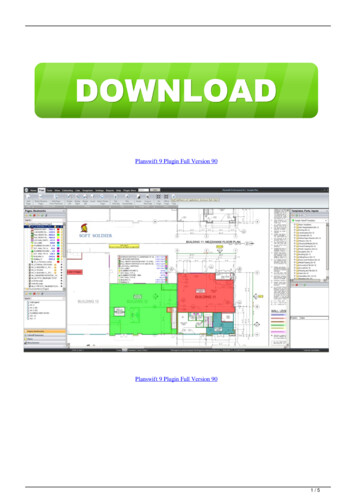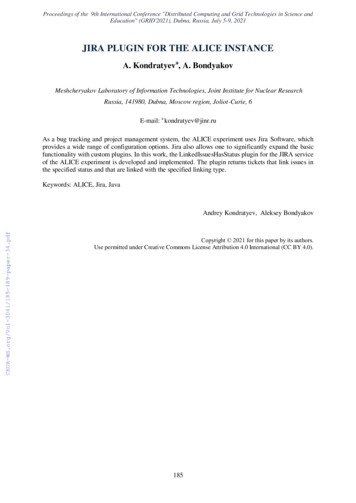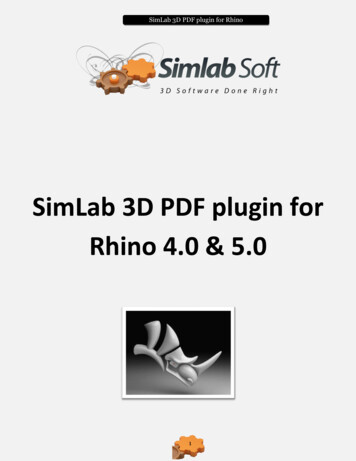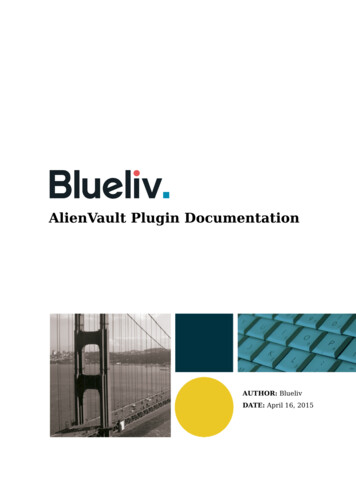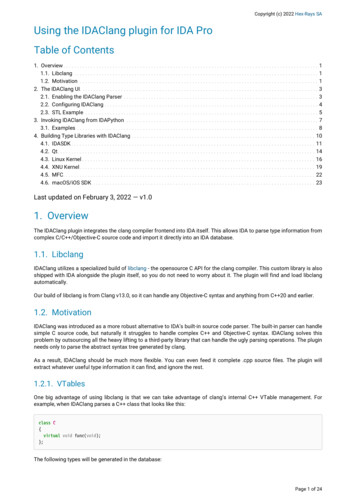
Transcription
Copyright (c) 2022 Hex-Rays SAUsing the IDAClang plugin for IDA ProTable of Contents1. Overview . . . . . . . . . . . . . . . . . . . . . . . . . . . . . . . . . . . . . . . . . . . . . . . . . . . . . . . . . . . . . . . . . . . . . . . . . . . . . . . . . . . . . . . . . . . . . 11.1. Libclang . . . . . . . . . . . . . . . . . . . . . . . . . . . . . . . . . . . . . . . . . . . . . . . . . . . . . . . . . . . . . . . . . . . . . . . . . . . . . . . . . . . . . . . . . 11.2. Motivation . . . . . . . . . . . . . . . . . . . . . . . . . . . . . . . . . . . . . . . . . . . . . . . . . . . . . . . . . . . . . . . . . . . . . . . . . . . . . . . . . . . . . . . 12. The IDAClang UI. . . . . . . . . . . . . . . . . . . . . . . . . . . . . . . . . . . . . . . . . . . . . . . . . . . . . . . . . . . . . . . . . . . . . . . . . . . . . . . . . . . . . . . 32.1. Enabling the IDAClang Parser . . . . . . . . . . . . . . . . . . . . . . . . . . . . . . . . . . . . . . . . . . . . . . . . . . . . . . . . . . . . . . . . . . . . . . . 32.2. Configuring IDAClang . . . . . . . . . . . . . . . . . . . . . . . . . . . . . . . . . . . . . . . . . . . . . . . . . . . . . . . . . . . . . . . . . . . . . . . . . . . . . . 42.3. STL Example . . . . . . . . . . . . . . . . . . . . . . . . . . . . . . . . . . . . . . . . . . . . . . . . . . . . . . . . . . . . . . . . . . . . . . . . . . . . . . . . . . . . . 53. Invoking IDAClang from IDAPython . . . . . . . . . . . . . . . . . . . . . . . . . . . . . . . . . . . . . . . . . . . . . . . . . . . . . . . . . . . . . . . . . . . . . . 73.1. Examples . . . . . . . . . . . . . . . . . . . . . . . . . . . . . . . . . . . . . . . . . . . . . . . . . . . . . . . . . . . . . . . . . . . . . . . . . . . . . . . . . . . . . . . . 84. Building Type Libraries with IDAClang . . . . . . . . . . . . . . . . . . . . . . . . . . . . . . . . . . . . . . . . . . . . . . . . . . . . . . . . . . . . . . . . . . . 104.1. IDASDK . . . . . . . . . . . . . . . . . . . . . . . . . . . . . . . . . . . . . . . . . . . . . . . . . . . . . . . . . . . . . . . . . . . . . . . . . . . . . . . . . . . . . . . . . 114.2. Qt. . . . . . . . . . . . . . . . . . . . . . . . . . . . . . . . . . . . . . . . . . . . . . . . . . . . . . . . . . . . . . . . . . . . . . . . . . . . . . . . . . . . . . . . . . . . . . 144.3. Linux Kernel . . . . . . . . . . . . . . . . . . . . . . . . . . . . . . . . . . . . . . . . . . . . . . . . . . . . . . . . . . . . . . . . . . . . . . . . . . . . . . . . . . . . . 164.4. XNU Kernel. . . . . . . . . . . . . . . . . . . . . . . . . . . . . . . . . . . . . . . . . . . . . . . . . . . . . . . . . . . . . . . . . . . . . . . . . . . . . . . . . . . . . . 194.5. MFC. . . . . . . . . . . . . . . . . . . . . . . . . . . . . . . . . . . . . . . . . . . . . . . . . . . . . . . . . . . . . . . . . . . . . . . . . . . . . . . . . . . . . . . . . . . . 224.6. macOS/iOS SDK . . . . . . . . . . . . . . . . . . . . . . . . . . . . . . . . . . . . . . . . . . . . . . . . . . . . . . . . . . . . . . . . . . . . . . . . . . . . . . . . . 23Last updated on February 3, 2022 — v1.01. OverviewThe IDAClang plugin integrates the clang compiler frontend into IDA itself. This allows IDA to parse type information fromcomplex C/C /Objective-C source code and import it directly into an IDA database.1.1. LibclangIDAClang utilizes a specialized build of libclang - the opensource C API for the clang compiler. This custom library is alsoshipped with IDA alongside the plugin itself, so you do not need to worry about it. The plugin will find and load libclangautomatically.Our build of libclang is from Clang v13.0, so it can handle any Objective-C syntax and anything from C 20 and earlier.1.2. MotivationIDAClang was introduced as a more robust alternative to IDA’s built-in source code parser. The built-in parser can handlesimple C source code, but naturally it struggles to handle complex C and Objective-C syntax. IDAClang solves thisproblem by outsourcing all the heavy lifting to a third-party library that can handle the ugly parsing operations. The pluginneeds only to parse the abstract syntax tree generated by clang.As a result, IDAClang should be much more flexible. You can even feed it complete .cpp source files. The plugin willextract whatever useful type information it can find, and ignore the rest.1.2.1. VTablesOne big advantage of using libclang is that we can take advantage of clang’s internal C VTable management. Forexample, when IDAClang parses a C class that looks like this:class C{virtual void func(void);};The following types will be generated in the database:Page 1 of 24
Copyright (c) 2022 Hex-Rays SAstruct cppobj C{C vtbl * vftable /*VFT*/;};struct /*VFT*/ C vtbl{void ( cdecl *func)(C *this);};To create the C vtbl type, IDAClang traverses clang’s internal VTableLayout data structure. This data structure is thesame mechanism that the clang compiler uses during the actual code generation. Thus, we can be very confident thatIDAClang is producing correct vtable types - even in much more complex situations. After all, clang knows what it’s doingin this regard.Moreover, when using IDAClang to generate a type library (see Building Type Libraries with IDAClang below), the pluginwill take advantage of clang’s name mangling to populate the symbol table:SYMBOLSFFFFFFFF 00000000 void cdecl ZN1C4funcEv(C *this);00000018 00000000 C vtbl layout ZTV1C;TYPESstruct C vtbl layout{int64 thisOffset;void *rtti;void ( cdecl *func)(C *this);};Here IDAClang created symbols for the C::func member function, as well as the mangled VTable symbol for the C class.1.2.2. TemplatesAnother notable advantage of using libclang is it allows us to gracefully handle C templates.For example, consider the following template declarations:template typename T, typename V struct S{T x;V y;};typedef S int, void * instance t;When clang parses the instance t declaration, internally it will generate a structure that represents the specializedtemplate S int, void * . The IDAClang plugin will then use this internal representation to generate a valid type for S int,void * in IDA’s type system:struct S int, void * {int x;void *y;};typedef S int, void * instance t;The type with name S int, void * represents the fully resolved structure, with all template arguments replaced. This allhappens automatically, and it is especially useful in more complex situations - such as template classes containingvirtual methods that depend on template parameters, resulting in specialized VTables.Page 2 of 24
Copyright (c) 2022 Hex-Rays SA2. The IDAClang UI2.1. Enabling the IDAClang ParserTo provide support for third-party parsers, IDA now has a new Source parser field in the Options Compiler dialog:To enable the IDAClang parser, select the clang parser from the dropdown menu:As a quick sanity check, try saving the following declaration in a file called test.h:typedef int myint t;Parse the file using menu File Load file Parse C header file. IDA should print this to the output window:/private/tmp/test.h: successfully compiledThe type should now be present in the Local Types view:Page 3 of 24
Copyright (c) 2022 Hex-Rays SA2.2. Configuring IDAClangOf course, IDAClang is capable of parsing source code that is much more complex. Often times this requires moredetailed configuration of the parser invocations.To support this, the Compiler Options dialog provides the Arguments field:In this field you can provide any argument you would typically provide to the clang compiler when invoking it from thecommand line. For example:One of the more important clang arguments is the -target option, which specifies the target architecture and platform.This allows clang to properly configure itself to parse macOS/Windows/Linux system headers. Clang calls this the target"triple" because it is often given in the form of:-target arch - vendor - platform Some examples:-target arm64-apple-darwin-target x86 64-pc-win32-target i386-pc-linuxThe various combinations of supported targets is documented in more detail here.Note that in the simple test.h example above, we did not specify a target platform. In this case clang will assume that thetarget platform is the same as the host machine IDA is currently running on. You can print the exact target used by clangby opening Options Compiler Parser specific options and enable the following option:Now when we use IDAClang to parse the test.h file, it will print a message:IDACLANG: triple: x86 64-apple-macosx10.15.0Which would be the typical output when IDA is running on macOS. On Windows the default will look something like:Page 4 of 24
Copyright (c) 2022 Hex-Rays SAIDACLANG: triple: x86 64-pc-windows-msvc19.29.30137And on Linux:IDACLANG: triple: x86 64-unknown-linux-gnuSuch is the default behavior within libclang, but clang supports a wide variety of platforms and architectures. You canalmost always specify a target that will match the input binary in the current database.2.3. STL ExampleNow let’s try invoking IDAClang on some more real-world source code.In this example, assume we are analyzing an x64 binary that makes heavy use of the C Standard Template Library.Then assume that at some point we want to create a structure that looks like this:#include#include#include#include string vector map set struct stl example t{std::string str;std::vector int vec;std::map std::string, int map;std::set char set;};This is the contents of stl/stl example.h from examples.zip. IDA’s default parser cannot handle such complex C syntax, so IDAClang is our only hope of importing this type. The precise configuration of IDAClang will vary betweenplatforms, so we’ll demonstrate them all separately.To parse stl example.h on macOS, we’ll have to point IDAClang to the macOS SDK as well as the STL system headers:-target x86 64-apple-darwin-x c -isysroot XcodeDefault.xctoolchain/usr/include/c .0.3/includeCopy the text above into the Options Compiler Arguments field.Note that we point IDAClang to the macOS SDK with the -isysroot option and use the -I option to allow IDAClang to findthe proper system headers in the Xcode toolchain. Be wary of the last option (ending with usr/lib/clang/11.0.3/include).This path contains the clang version number, so it might be different on your machine. Also make special note of the -xc option. This is used to inform libclang that the input source will not be plain C, which is the default syntax for .h filesin libclang.Now we can use File Load file Parse C header file to parse stl example.h. This will generate a useful type forstl example t in our database:Page 5 of 24
Copyright (c) 2022 Hex-Rays SAOn Windows the configuration is a bit different. If you’re using Visual Studio, libclang is normally able to detect commonheader paths automatically.Thus you will likely only need to specify the following arguments in Options Compiler Arguments:-target x86 64-pc-win32 -x c Ideally this will be enough to parse stl example.h and generate some useful type info:If for whatever reason the heuristics within libclang fail to find the headers on your system, it is very easy to specify theheader paths manually. Simply open a Visual Studio x64 Command Prompt and run the following command:echo %INCLUDE%This will print a semicolon-separated list of the header paths used on your system:This list can be copied directly into the Options Compiler Include directories field in IDA. IDAClang will automaticallyprocess this list and pass the header paths to clang upon invocation of the parser. This is likely enough to handle mostPage 6 of 24
Copyright (c) 2022 Hex-Rays SAWindows-based source code.On Linux you can determine the header paths used your system by running the following command:cpp -vThis will print something like:#include . search starts here:/usr/lib/gcc/x86 cc/x86 64-linux-gnu/6/include-fixed/usr/include/x86 64-linux-gnu/usr/includeYou can then use these arguments in the Options Compiler Arguments field in IDA:-target x86 64-pc-linux-gnu-x c -I/usr/lib/gcc/x86 ib/gcc/x86 64-linux-gnu/6/include-fixed-I/usr/include/x86 64-linux-gnu-I/usr/includeThen use File Load file Parse C header file to parse stl example.h.3. Invoking IDAClang from IDAPythonLike any good IDA feature, IDAClang can also be invoked from an IDAPython script.IDA 7.7 introduced the ida srclang module to provide simple support for invoking third-party parsers from IDAPython.Use the following IDAPython commands for an overview of this new module:import ida srclang? ida srclang? ida srclang.parse decls with parser? ida srclang.set parser argvThe function ida srclang.parse decls with parser can notably be used to parse source code snippets:Python ? ida srclang.parse decls with parserHelp on function parse decls with parser in module ida srclang:parse decls with parser(*args) - 'int'Parse type declarations using the parser with the specified name@param parser name: (C : const char *) name of the target parser@param til: (C : til t *) type library to store the types@param input: (C : const char *) input source. can be a file path or decl string@param is path: (C : bool) true if input parameter is a path to a source file, false if theinput is an in-memory source snippet@retval -1: no parser was found with the given name@retval else: the number of errors encountered in the input sourceIf the is path argument is False, this function will assume the input argument is a string that represents a source codesnippet. Otherwise it will be considered a path to a source file on disk. Also note the til parameter, which will often timesbe None. This ensures the parsed types are imported directly into the current database.Page 7 of 24
Copyright (c) 2022 Hex-Rays SA3.1. ExamplesIMPORANT NOTE: when libclang parses in-memory strings, it makes no assumptions about the expected syntax. Thus,you must specify the -x option to tell clang which syntax to expect before invoking the parser. Here are the the knownsyntax directives:-x-x-x-xcc objective-cobjective-c For example, this is how you would use ida srclang to parse a simple C source string with IDAClang:import ida srclang# tell clang the expected syntaxida srclang.set parser argv("clang", "-x c")# parse a type stringida srclang.parse decls with parser("clang", None, "typedef int myint t;", False)3.1.1. STL Example RevisitedWe can also handle the same STL example discussed previously, but this time parse stl example t as a source snippet:import ida srclangclang argv ["-target x86 64-apple-darwin","-x c ","-isysroot ns/XcodeDefault.xctoolchain/usr/include/c /11.0.3/include",]ida srclang.set parser argv("clang", " ".join(clang argv))decl """#include string #include vector #include map #include set struct stl example t{std::string str;std::vector int vec;std::map std::string, int map;std::set char set;};"""ida srclang.parse decls with parser("clang", None, decl, False)This should produce an identical result as before when we used File Load file Parse C header file for stl example.h.3.1.2. Boost ExampleIn this example we will show how IDAClang can be used in batch mode to improve the analysis of a binary compiled fromBoost headers. The experiment will be performed on Debian Linux with gcc 6.3.0.Consider the following source files from the boost/ directory in examples.zip: chat server.cpp chat message.hppThese sources were taken directly from the Boost 1.77 examples, and we’ll use them to compile a test binary. Begin byPage 8 of 24
Copyright (c) 2022 Hex-Rays SAdownloading the Boost 1.77.0 headers, then compile the chat server application:g -I boost 1 77 0 -std c 11 -o chat server.elf chat server.cpp -lpthreadSince Boost is a template library, it will generate a bloated binary that contains thousands of instantiated templatefunctions. Thus, IDA’s initial analysis of chat server.elf will likely not be very pretty. How can IDAClang help us with this?Consider boost/chat server.py from examples.zip.importimportimportimportsysida proida autoida srclangclang argv {"-target x86 64-pc-linux","-x c ","-std c 11","-I./boost 1 77 0",# NOTE: include paths were copied from the output of cpp -v . they might differ on your machine."-I/usr/lib/gcc/x86 /usr/lib/gcc/x86 64-linux-gnu/6/include-fixed","-I/usr/include/x86 64-linux-gnu","-I/usr/include",}# invoke the clang parserida srclang.set parser argv("clang", " ".join(clang argv))ida srclang.parse decls with parser("clang", None, "./chat server.cpp", True)# analyze the input fileida auto.auto mark range(0, BADADDR, AU FINAL)ida auto.auto wait()# save and exitida pro.qexit(0)This script will configure IDAClang to parse the chat server.cpp source file and extract any type information it finds, thenanalyze the input with the imported type info, and saves the resulting database in chat server.i64. You can run the scriptlike this:idat64 -c -A -Schat server.py -Oidaclang:t -ochat server.i64 -Lchat server.log chat server.elfYou may have noticed this option:-Oidaclang:tThis option is passed to the IDAClang plugin and it enables CLANG APPLY TINFO (see idaclang.cfg for more info).Now let’s open the resulting database chat server.i64 in IDA, and try decompiling some functions. Immediately we seethat the analysis does benefit from the imported type info. For example chat session::do write seems somewhatintelligible after some minor simplifications:Page 9 of 24
Copyright (c) 2022 Hex-Rays SASince IDAClang parsed the chat session class, we now have a correct prototype for chat session:do write, as well as avalid chat session structure. Note that references to chat session.write msgs (std::deque chat message ) andchat session.socket (boost::asio::ip::tcp::socket) were correctly resolved.Granted, this is not the most realistic example. It’s not often we have access to the full source code of the target binary,but hopefully this shows that whenever any relevant source code is available, IDAClang can take full advantage.4. Building Type Libraries with IDAClangThe IDAClang plugin is useful for enriching your database with complex type information, but often times the importedtypes are relevant to more than just one database. In this section we discuss how you can use IDAClang to generate rich,generic type libraries for IDA Pro.Hex-Rays also provides a command-line version of IDAClang, specifically designed for building custom Type InformationLibraries (TILs) that can be loaded into any IDA database.After downloading the idaclang binary, copy it to the idabin/ directory of your IDA installation (next to the libclang dll).For an overview of idaclang’s functionality, run:idaclang -hFor a quick demonstration, save the following source in a file named test.h:class C{virtual void func(void);};You can compile this header into a type library by invoking idaclang the same way you would typically invoke the clangcompiler from the command line:idaclang -x c -target x86 64-pc-linux test.hThis will generate a file called test.til that contains all types that were parsed in test.h. Try dumping the TIL with the tilibutility.tilib -l /tmp/test.tilPage 10 of 24
Copyright (c) 2022 Hex-Rays SATYPE INFORMATION LIBRARY CONTENTSDescription:Flags: 0107 compressed macro table present extended sizeof info sizeof long doubleBase tils :Compiler: GNU C sizeof(near*) 8 sizeof(far*) 8 near code, near data, cdecldefault align 0 sizeof(bool) 1 sizeof(long) 8 sizeof(llong) 8sizeof(enum) 4 sizeof(int) 4 sizeof(short) 2sizeof(long double) 16SYMBOLSFFFFFFFF 00000000 void cdecl ZN1C4funcEv(C * hidden this);00000018 00000000 C vtbl layout ZTV1C;TYPES00000008 struct cppobj C {C vtbl * vftable /*VFT*/;};00000008 struct /*VFT*/ C vtbl {void ( cdecl *func)(C * hidden this);};00000018 struct C vtbl layout { int64 thisOffset;void *rtti;void ( cdecl *func)(C * hidden this);};MACROSTotal 2 symbols, 3 types, 0 macrosThe tool also provides extra arguments to configure the til generation. They are given the --idaclang- prefix so they canbe easily separated from the clang arguments. For example:idaclang --idaclang-tilname /tmp/test2.til -x c -target x86 64-pc-linux test.hThis will create the library at /tmp/test2.til, instead of the default location.Now let’s try building some type libraries from real-world code. The examples in this section will demonstrate the powerof IDAClang by creating TILs from many different opensource C projects. They cover a large variety of platforms,architectures, and codebases, so it is best to unify the build system using makefiles.At the top level of examples.zip there should be a makefile named idaclang.mak:IDACLANG ARGS --idaclang-log-allIDACLANG ARGS --idaclang-tilname (TIL NAME)IDACLANG ARGS --idaclang-tildesc (TIL DESC)CLANG ARGV -ferror-limit 50all: (TIL NAME).PHONY: all (TIL NAME) clean (TIL NAME): (TIL NAME).til (TIL NAME).til: (TIL NAME).mak (INPUT FILE)idaclang (IDACLANG ARGS) (CLANG ARGV) (INPUT FILE) (TIL NAME).logtilib64 -ls (TIL NAME).til (TIL NAME).til.txtclean:rm -rf *.til *.txt *.logThis makefile defines a simple rule for building a TIL using the idaclang command-line utility. It will be used extensively inthe following examples.4.1. IDASDKHex-Rays publishes an SDK for developing custom IDA plugins, which is comprised mostly of C header files. Thus, it isa perfect use case for IDAClang. In this example we will build a type library for IDA itself, using IDA SDK 7.7.After downloading idasdk77.zip, unzip it into the idasdk subdirectory of examples.zip.To build this TIL we only need to create a single header file that includes all headers from the IDA SDK, and then parsethis file with idaclang. See examples/idasdk/idasdk.h, which contains include directives for all files in idasdk77/include(they happen to be in alphabetical order, but the order shouldn’t matter much):Page 11 of 24
Copyright (c) 2022 Hex-Rays SA#include auto.hpp #include bitrange.hpp #include bytes.hpp // . etc#include typeinf.hpp #include ua.hpp #include xref.hpp The IDAClang configuration required to parse idasdk.h is highly platform-dependent, so we provide separate makefilesfor each of IDA’s supported platforms.To demonstrate how we might build idasdk.h on MacOSX, see examples/idasdk/idasdk mac x64.mak:TIL NAME idasdk mac x64TIL DESC "IDA SDK headers for MacOSX"INPUT FILE idasdk.hSDK OOLCHAIN ins/XcodeDefault.xctoolchainCLANG ARGV -target x86 64-apple-darwin\-x objective-c \-isysroot (SDK)\-I (TOOLCHAIN)/usr/include/c /v1\-I (TOOLCHAIN)/usr/lib/clang/11.0.3/include \-I./idasdk77/include/\-D MAC\-D EA64\-Wno-nullability-completenessinclude ./idaclang.makYou can build the TIL with:make -f idasdk mac x64.makThis will generate a type library named idasdk mac x64.til, along with a dump of the til contents inidasdk mac x64.til.txt. In the text dump we might notice some familiar types:00000010 struct cppobj range t{ea t start ea;ea t end ea;};// 0. 0000 0008 effalign(8) fda 0 bits 0000 range t.start ea ea t;// 1. 0008 0008 effalign(8) fda 0 bits 0000 range t.end ea ea t;//0010 effalign(8) sda 0 bits 0080 range t struct packalign 000000050 struct cppobj memory info t : range t{qstring name;qstring sclass;ea t sbase;uchar bitness;uchar perm;};// 0. 0000 0010 effalign(8) fda 0 bits 0020 memory info t.range t range t;// 1. 0010 0018 effalign(8) fda 0 bits 0000 memory info t.name qstring;// 2. 0028 0018 effalign(8) fda 0 bits 0000 memory info t.sclass qstring;// 3. 0040 0008 effalign(8) fda 0 bits 0000 memory info t.sbase ea t;// 4. 0048 0001 effalign(1) fda 0 bits 0000 memory info t.bitness uchar;// 5. 0049 0001 effalign(1) fda 0 bits 0000 memory info t.perm uchar;//004A unpadded size//0050 effalign(8) sda 0 bits 0080 memory info t struct packalign 0Page 12 of 24
Copyright (c) 2022 Hex-Rays SAIt’s worth building a separate til for both x64 and arm64 macOS. IDA’s source code is not very architecture dependent,but many system headers might be. So it’s best to be as precise as possible.To build this TIL on macOS12 for Apple Silicon, the approach is very similar:TIL NAME idasdk mac arm64TIL DESC "IDA SDK headers for arm64 macOS 12"INPUT FILE idasdk.hSDK OLCHAIN ins/XcodeDefault.xctoolchainCLANG ARGV -target arm64-apple-darwin\-x objective-c \-isysroot (SDK)\-I (TOOLCHAIN)/usr/lib/clang/13.0.0/include \-I./idasdk77/include/\-D MAC\-D EA64\-D ARM\-Wno-nullability-completenessinclude ./idaclang.makNote that we did not provide the path to the C STL headers like we did in idasdk mac x64.mak. On macOS12 the C headers are shipped within MacOSX12.0.sdk, so there is no need to explicitly tell idaclang where to find them.To parse idasdk.h on Windows, use examples/idasdk/idasdk win.mak:TIL NAME TIL DESC INPUT FILECLANG ARGVidasdk win"IDA SDK headers for x64 Windows" idasdk.h -target x86 64-pc-win32\-x c \-I./idasdk77/include\-D NT\-D EA64\-Wno-nullability-completenessinclude ./idaclang.makNormally we do not need to specify any include paths, since idaclang can find the Visual Studio headers automatically. Ifit can’t, you can always explicitly provide include paths with the -I option.Building idasdk.h on Linux is also fairly straightforward. See idasdk linux.mak:TIL NAME idasdk linuxTIL DESC "IDA SDK headers for x64 linux"INPUT FILE idasdk.hGCC VERSION (shell expr gcc -dumpversion cut -f1 -d. )CLANG ARGV -target x86 64-pc-linux-x c -I/usr/lib/gcc/x86 64-linux-gnu/ (GCC /x86 64-linux-gnu/ (GCC VERSION)/include-fixed-I/usr/include/x86 64-linux-gnu-I/usr/include-I./idasdk77/include/-D LINUX-D EA64-Wno-nullability-completeness\\\\\\\\\\include ./idaclang.makYou can also include the decompiler types from the hexrays SDK in the type library for idasdk77. Simply copyhexrays.hpp from hexrays sdk/ in your IDA installation to idasdk77/include/, then add this line to idasdk.h:Page 13 of 24
Copyright (c) 2022 Hex-Rays SA#include hexrays.hpp Then rebuild the TIL. It will likely yield some useful decompiler types:00000050 struct cppobj minsn t{mcode t opcode;int iprops;minsn t *next;minsn t *prev;ea t ea;mop t l;mop t r;mop t d;};// 0. 0000 0004 effalign(4) fda 0// 1. 0004 0004 effalign(4) fda 0// 2. 0008 0008 effalign(8) fda 0// 3. 0010 0008 effalign(8) fda 0// 4. 0018 0008 effalign(8) fda 0// 5. 0020 0010 effalign(8) fda 0// 6. 0030 0010 effalign(8) fda 0// 7. 0040 0010 effalign(8) fda 0//0050 effalign(8) sda 0bits 0000bits 0000bits 0000bits 0000bits 0000bits 0000bits 0000bits 0000bits 0080minsn t.opcode mcode t;minsn t.iprops int;minsn t.next minsn t *;minsn t.prev minsn t *;minsn t.ea ea t;minsn t.l mop t;minsn t.r mop t;minsn t.d mop t;minsn t struct packalign 000000028 struct cppobj minsn visitor t : op parent info t{minsn visitor t vtbl * vftable /*VFT*/;};// 0. 0000 0008 effalign(8) fda 0 bits 0100 minsn visitor t. vftable minsn visitor t vtbl *;// 1. 0008 0020 effalign(8) fda 0 bits 0020 minsn visitor t.op parent info t op parent info t;//0028 effalign(8) sda 0 bits 0080 minsn visitor t struct packalign 04.2. QtIn this example we will build a type library for the Qt Opensource UI Framework. The example uses Qt 5.15.2, buttheoretically it can work for any Qt version. We assume you already have a Qt installation present on your system (Seethe QTDIR variable in the following makefiles).Let’s start by creating a file that includes as many Qt headers as we can. Qt makes this easy because they ship"umbrella" headers for the various sub-frameworks, which take care of including most of the critical Qt header files.See examples/qt/qt.h from e#include#include#include#include QtCore QtGui QtWidgets QtPrintSupport QtNetwork QtConcurrent QtDBus QtDesigner QtDesignerComponents QtHelp QtOpenGL QtSql QtTest QtUiPlugin QtXml This will be more than enough to get started.To build qt.h on macOS, consider examples/qt/qt mac.mak:Page 14 of 24
Copyright (c) 2022 Hex-Rays SATIL NAME qt macTIL DESC "Qt 5.15.2 headers for x64 macOS"INPUT FILE qt.hQTDIR /Users/Shared/Qt/5.15.2-x64SDK OOLCHAIN ins/XcodeDefault.xctoolchain/CLANG ARGV -target x86 64-apple-darwin\-x objective-c \-isysroot (SDK)\-I (TOOLCHAIN)/usr/include/c /v1\-I (TOOLCHAIN)/usr/lib/clang/11.0.3/include\-F (QTDIR)/lib/\-I (QTDIR)/lib/QtCore.framework/Headers\-I (QTDIR)/lib/QtGui.framework/Headers\-I (QTDIR)/lib/QtWidgets.framework/Headers\-I (QTDIR)/lib/QtPrintSupport.framework/Headers\-I (QTDIR)/lib/QtNetwork.framework/Headers\-I (QTDIR)/lib/QtCLucene.framework/Headers\-I (QTDIR)/lib/QtConcurrent.framework/Headers\-I (QTDIR)/lib/QtDBus.framework/Headers\-I (QTDIR)/lib/QtDesigner.framework/Headers\-I (QTDIR)/lib/QtDesignerComponents.framework/Headers \-I (QTDIR)/lib/
2.3. STL Example Now let's try invoking IDAClang on some more real-world source code. In this example, assume we are analyzing an x64 binary that makes heavy use of the C Standard Template Library. Then assume that at some point we want to create a structure that looks like this: #include string #include vector #include map #include set

